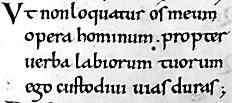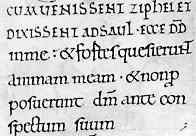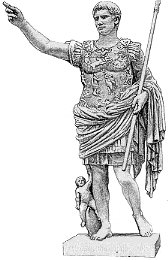|
|
|
 |
|
The
History of Scripts |
| Handwriting
is an individualistic craft and each scribe
writes a little differently. However, over time the forms of letters and
the style of writing have changed. Different styles have also developed
for particular purposes, so that even in the same time and place, the
handwriting of a majestic book of church liturgy,
designed for reading aloud in solemn performance, may be different to
that of a more modest book, and to that of a royal charter,
and to that of a scribe in a court of law, and to that of a tired and
irritable university student. |
 |
 |
| Two
examples from one document showing the variations in hands between two scribes
writing in essentially the same script, Caroline minuscule. The book is an
11th century manuscript, the Harley Psalter (British Library, Harley 603),
by permission of the British Library. |
| Despite
the variations, there are recognisable patterns of change which have occurred
over time as writing has evolved. Styles of writing can be categorised
into named scripts
which can be identified as to their time and place of origin. Because
of the natural variation and fluid relationships between these products
of individual human creativity, the classification and nomenclature of
scripts is somewhat variable. There are trends, developments of very different
general categories of script, periods of diversification and periods of
consolidation of styles. Change has sometimes occurred rapidly and sometimes
slowly.
|
| The
history of script changes reflects aspects of the history of the literate
world. They are of interest not only to those who have a fascination for the
changing shapes of letters, but to those with a more general interest in the
history of social and cultural processes. |
| The
scripts used by the Romans were used throughout the Empire and formed
the basis for all later developments. After the fall of the Empire, surviving
and reviving centres of literacy developed a diversity of scripts based
on the Roman model. The script known as Caroline
minuscule was developed in the revival of literacy and Classical culture
which occurred under the Emperor Charlemagne. This became a standard across
much of literate Europe by the 10th century. A new wave of diversification
began in northern France and the Low Countries in the 11th century, resulting
in the development of the large and diverse family of scripts known as
Gothic. In the
Renaissance period in Italy, a return to aspects of Classical culture
included the revival of what were perceived as Classical scripts. This
era represented the end of manuscript book production to any significant
degree, although a range of stylised hands for document production remained
in use. |
|
|
The
enperor Augustus |
| Many of the script examples illustrated in the History of Scripts section are examined in much greater detail in the paleography section of this website, Start with the Index of Scripts, and follow each example through its set of paleography exercises. Don't worry, they don't bite! A little pixie, or is that pixel, holds your hand and leads you through the reading of each sample of script. |
|
Roman
scripts |
|
Post-Roman
scripts |
|
Caroline
minuscule  |
|
Gothic
variations |
|
Classical
revival |
|
 What
is Paleography? What
is Paleography?
|
|
 |
 |
 |


